Chris Hemsworth 12 Strong
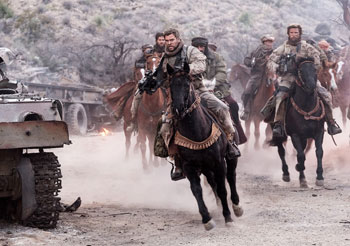
The first Special Forces team deployed to Afghanistan after 9/11
Cast: Chris Hemsworth, Michael Shannon, William Fichtner
Director: Nicolai Fuglsig
Genre: Action, Drama, History
Rated: MA
Synopsis: Chris Hemsworth and Oscar nominee Michael Shannon star in '12 Strong," a powerful new war drama from Alcon Entertainment, Black Label Media and Jerry Bruckheimer Films about the U.S. Army's Special Forces' covert incursion into Taliban-held Afghanistan. It tells the now declassified true story of the first 12 American soldiers sent into the region for this extremely dangerous mission, mere days after 9/11.
Award-winning director Nicolai Fuglsig directed the film, which is produced by legendary producer Jerry Bruckheimer, together with Molly Smith, Trent Luckinbill and Thad Luckinbill under their Black Label Media banner. Oscar winner Ted Tally and Peter Craig wrote the screenplay, based on the acclaimed book Horse Soldiers by author Doug Stanton. The executive producers are Oscar nominees and Alcon principals Andrew A. Kosove and Broderick Johnson, together with Chad Oman, Mike Stenson, Ellen H. Schwartz, Garrett Grant, Yale Badik, Val Hill and Doug Stanton.
12 Strong is set in the harrowing days following 9/11 when an elite U.S. Special Forces unit, led by their Captain, Mitch Nelson (Hemsworth), is selected to be the first U.S. soldiers to provide an offensive response to the unprecedented attacks on U.S. soil. Leaving their families behind, the team is dropped into the remote, rugged landscape of northern Afghanistan, where they must convince General Abdul Rashid Dostum (Navid Negahban) to join forces with them to fight their common adversary: the Taliban and their Al Qaeda allies.
In addition to overcoming mutual distrust and a vast cultural divide, the Americans" accustomed to state-of-the-art warfare"must adopt the unfamiliar tactics of the Afghan horse soldiers. Despite forming an uneasy bond and growing respect, the new allies face overwhelming odds: vastly outnumbered and outgunned by a ruthless enemy that does not take prisoners.
12 Strong
Release Date: March, 2018
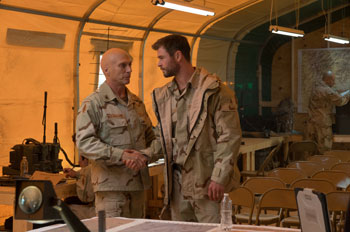 About The Production
About The Production
I ain't losing one man on this team.
The only way home is winning.
Every American adult knows exactly where they were and what they were doing on the terrible morning of September 11, 2001. But until recently, only a small handful knew about the extraordinary events that unfolded in the immediate aftermath. With the country still reeling, 12 brave members of the U.S. Army's elite Special Forces"known as the Green Berets"left their homes and loved ones to take on a perilous classified mission in the war-torn country of Afghanistan. These 12 Strong were chosen to strike the first blow in America's response to the terrorist attacks.
They were not ordered to go. They volunteered to go.
Now the true story of these dozen warriors is being brought to the big screen in the new action drama 12 Strong. Producer Jerry Bruckheimer offers, 'While the American public was still in shock, these men ventured into the unknown, into a situation fraught with danger, to try and settle the score and bring us a victory. They had to leave their wives and kids at a moment's notice, with both they and their families not knowing where they were going or if they'd ever make it back. The operation was classified for a number of years"most people have never even heard of the story"but these men are true heroes."
12 Strong director Nicolai Fuglsig adds, 'They were the tip of the spear, the first American soldiers on the ground in Afghanistan. When they arrived, they found themselves outnumbered 5,000 to 1 by the enemy and were constantly at risk of getting captured because of the huge bounty the Taliban had placed on their heads."
Codenamed Task Force Dagger, the mission was as much diplomatic as it was military. Nicolai Fuglsig explains, 'This small Special Forces team was to link up with a local warlord named General Abdul Rashid Dostum, a leader in Afghanistan's Northern Alliance, in an effort to help him regain control of the region. It was the initial step in America's fight against the Taliban and Al Qaeda after 9/11."
The Northern Alliance, a fragile coalition of Afghan military leaders, had itself become somewhat fractured in the years since its formation in 1996, but, regardless, there was one thing that united them: their mutual desire to rid their country of the ruthless Taliban. Chris Hemsworth, who stars as Captain Mitch Nelson, the leader of the Special Forces team, notes, 'These Green Berets weren't there as occupiers; they were there to assist the Afghan people who had been fighting for their freedom. Without much prior intel, they had to come in and earn the trust of Dostum and his men or they could never have accomplished their mission. What I loved about this story was it was a chance to show Americans working side-byside with the Afghan people to fight a common enemy."
Jerry Bruckheimer calls the mission 'unprecedented" for another reason. Despite being among the best-trained soldiers in any branch of the military, the 12 Green Berets were unprepared for one unique challenge: in northern Afghanistan's treacherously steep, mountainous terrain, the transportation modes of modern warfare had to give way to something more basic. 'The only way through the mountain passes is on mules or horses, so they had to adapt," the producer details. 'Only one of them was an expert rider, so the rest had to learn on the run."
For the first time in 60 years, 'Americans were heading into battle on horseback," Nicolai Fuglsig observes. 'But now they were riding into combat against missile launchers and T-72 tanks. The fact that every member of that Special Forces team made it home alive is nothing short of a miracle."
The extraordinary story of the Green Berets known as ODA (Operational Detachment Alphas) 595 was first chronicled by author Doug Stanton in the 2009 bestseller Horse Soldiers: The Extraordinary Story of a Band of U.S. Soldiers Who Rode to Victory in Afghanistan. However, Jerry Bruckheimer recalls, 'Even before the book was finished, it was brought to us in galley form. Doug Stanton is a fantastic writer; we loved it right away. I thought it was an amazing true story"intense and heroic, with stunning action. And, remarkably enough, there have been very few films made about the Army's Special Forces. They are known as -the quiet professionals' because their missions are covert and, for obvious reasons, they rarely publicise their exploits."
For Doug Stanton, who also served as an executive producer on the film, the prospect of having Jerry Bruckheimer bring his book to life as a major motion picture version of his book seemed like the proverbial match made in heaven. 'I've been a fan of Jerry Bruckheimer's for a long time," he affirms. 'When I saw -Black Hawk Down,' from the first frame I said, -This is a filmmaker who knows how to tell these stories.' They're both stories about war, but ultimately, they are about people trying to make a difficult decision at the least opportune moment."
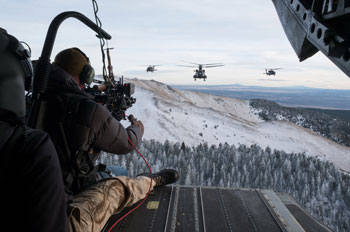 After developing the project for several years, Bruckheimer Films teamed with Molly Smith, Trent Luckinbill and Thad Luckinbill at Black Label Media, and Alcon Entertainment's Andrew A. Kosove and Broderick Johnson to bring '12 Strong" to fruition. 'Black Label and Alcon were terrific partners for us in producing the movie," says Chad Oman, President of Jerry Bruckheimer Films and an executive producer on the film. 'They were as passionate about the project as we had been since we first read Doug Stanton's captivating book, agreeing that this was an important, yet largely unknown, story that needed to be told on film. It was a really positive and rewarding collaboration from beginning to end."
After developing the project for several years, Bruckheimer Films teamed with Molly Smith, Trent Luckinbill and Thad Luckinbill at Black Label Media, and Alcon Entertainment's Andrew A. Kosove and Broderick Johnson to bring '12 Strong" to fruition. 'Black Label and Alcon were terrific partners for us in producing the movie," says Chad Oman, President of Jerry Bruckheimer Films and an executive producer on the film. 'They were as passionate about the project as we had been since we first read Doug Stanton's captivating book, agreeing that this was an important, yet largely unknown, story that needed to be told on film. It was a really positive and rewarding collaboration from beginning to end."
Producer Trent Luckinbill says they appreciated the opportunity to collaborate for the first time with Jerry Bruckheimer. 'Jerry Bruckheimer has had one of the most prolific careers in the industry, so he obviously brings a lot of experience. He's very engaged, very hands on, and his energy is boundless. We were excited to learn from him."
'As a company, we respond to incredible true stories, so when we read the script, we were blown away," producer Molly Smith relates. 'It told of what happened in the days after 9/11, which is something people around the world need to know. It's a tale of courage and heroism of the highest degree."
In addition to recounting the remarkable story of the first Special Forces team on the ground in Afghanistan, '12 Strong" also recognises the courage of those left behind. As seen early in the film, their wives and children are also faced with the sacrifices that come with military service...even when you don't wear a uniform. Molly Smith confirms, 'I think it's very important in a war movie or a film about the military that you not only get to see what it's like for these men to leave their wives and their children but also the effect it has on their families."
For the men, there are conflicting emotions in saying goodbye to one family to fight alongside another"their brothers in arms. Nicolai Fuglsig expands, 'Most of these guys had been working closely together for years. When you're responsible for each other's lives, the bond that forms is much more that of a brotherhood than a team."
Ted Tally and Peter Craig had the task of adapting Stanton's comprehensive non-fiction account into a taut cinematic screenplay. 'When I first came upon the book I was mesmerized by it," Tally relates. 'I'm a history buff, and this was a slice of epic history that I didn't know about, and I imagine most people don't know about it either. I was struck by the courage and ingenuity of the American soldiers and of their Afghan allies. And what makes it even more fascinating is that it's 21st-century warriors in a centuries-old environment and culture. Here were the most highly trained soldiers in the United States, and now they were being forced to completely improvise in ways no one had foreseen.
'One of the things that really moved me about this story was that these Green Berets were all grown men," Tally continues. 'They weren't fresh-faced boys; they were mature men with wives and kids taking on this risk for their country and eager to do it. They knew what it could mean, they understood what they were sacrificing, but that's their training. That's their instinct."
The script was one of the things that drew Nicolai Fuglsig to the project, which would mark the director's feature film debut. He recalls, 'Jerry Bruckhimer sent me the script and I loved the story so much that I immediately went and read the book."
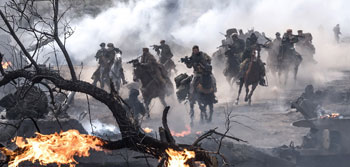 Jerry Bruckheimer says, 'Nicolai Fuglsig is an extraordinary visual artist who has won awards for his commercial work. He also has a background as a documentarian and as a photojournalist who has shot all over the world and covered the war in Kosovo. He has a unique eye and we felt fortunate to work with him on his first movie."
Jerry Bruckheimer says, 'Nicolai Fuglsig is an extraordinary visual artist who has won awards for his commercial work. He also has a background as a documentarian and as a photojournalist who has shot all over the world and covered the war in Kosovo. He has a unique eye and we felt fortunate to work with him on his first movie."
'As a photojournalist, I have seen war firsthand and definitely experienced some very intense moments," Nicolai Fuglsig notes. 'In a way, all wars are somewhat similar when you consider the element of human tragedy, but I think this film is a very different type of war drama. The Americans come to help the Afghans fight their own battle against the Taliban, so these people from two very different cultures have to learn to work together for a shared cause."
The director's vision for the project impressed all of the producers. 'Nicolai Fuglsig went out and did an enormous amount of research on the Special Forces who were over there," says Jerry Bruckheimer. 'Somehow, he even got his hands on a government report on the operation. So he came in with photographs he'd gathered and offered a fresh point of view on how he would make the movie."
Producer Thad Luckinbill, who also portrays one of the '12 Strong," remarks, 'The amount of work he had done, the thoughtfulness that had gone into the presentation, the integrity with which he wanted to present this story...it was just unmatched. Visually, he's such a beautiful shooter, who understands the camera and the frame. But to hear his passion for the project and his understanding of the story, it was a no-brainer. He was the guy."
While Tally and Craig's writing adhered closely to the actual events as told in Stanton's book, as with all screen adaptations, some dramatic license was taken. For example, all but a few names of the ODA-595 team had been changed by the author to protect the soldiers' identities on what was still a classified mission at the time of writing, and those fictional names were retained in the film. 'We were making a feature film and not a documentary," says Jerry Bruckheimer, 'but both Ted and Peter expertly found a way to tell the story in a manner that was true to the essence of the events and the characters."
Nevertheless, from the beginning, verisimilitude became a watchword for the filmmakers, who all wanted to do justice to this true story. They brought in military consultants and also relied on the expertise of Doug Stanton, whom Jerry Bruckheimer calls 'a great colleague for us throughout the process. One way he helped us was by hooking us up with the Special Forces" men who were actually involved in Task Force Dagger."
Two of those men were Mark Nutsch, ODA-595 Special Forces Captain and detachment commander on the mission, and his assistant detachment commander and Chief Warrant Officer Bob Pennington. They are the real-life counterparts to the roles played by Chris Hemsworth and Michael Shannon, respectively.
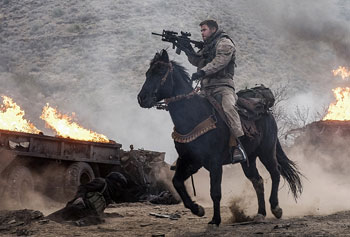 Bob Pennington states that being the tip of the spear after the 9/11 attacks 'was our proudest accomplishment ever. To me, it was the pinnacle. We had the primo mission given to us. Now, let's roll."
Bob Pennington states that being the tip of the spear after the 9/11 attacks 'was our proudest accomplishment ever. To me, it was the pinnacle. We had the primo mission given to us. Now, let's roll."
'We're humbled that a movie has been made about our team's mission in that pivotal post-9/11 period," Nutsch adds. 'It also means a great deal to our families, who sacrifice so much, that what we accomplished is finally being brought more into public light. And I believe it will mean a lot to the Afghan people because it shows their service in that conflict."
Acknowledging all his comrades in arms, Nutsch continues, 'We are truly honored that '12 Strong' captures the spirit of the U.S. Army Special Forces. I think it's important to show what the power and capabilities of the Green Berets are. They are people who are driven and expect a high standard of themselves and their teammates. We really pushed each other, and we were better for it."
'This movie superbly portrays a Special Forces team in the battlefield as they should be portrayed," says Pennington. It really shows some of what we went through, how we adapted to situations and overcame some serious challenges."
Lieutenant General John Mulholland"then a colonel and the man who selected ODA- 595 to go into Afghanistan"reveals that one of the team's primary hurdles was that they'd be heading into the mission essentially blind. He explains, 'Before undertaking an Unconventional Warfare mission behind enemy lines to work with indigenous peoples, U.S. Army Special Forces dedicate an enormous amount of time and energy studying the culture, history, political complexities and idiosyncrasies of both the people and the event in order to build the rapport with our indigenous partners that is absolutely essential to achieve the objectives that both they and the United States share. In the wake of the terrible attacks of 9/11, and the need for essentially an immediate response, our teams were required to go in almost overnight and join up with people they'd never had the time to study, never worked with, and whose language they did not speak. In fact, the list of what we didn't know massively outweighed what we did know. Yet, despite those handicaps, our men did an exceptional job on an extraordinarily dangerous mission to accomplish our goal of defeating and overthrowing the Taliban regime."
Michael Shannon, who plays Chief Warrant Officer Hal Spencer, attests that meeting some of their counterparts was a great benefit to the cast. 'It meant a lot to us that they did come because if you're going to tell a story like this, it's really your responsibility to tell it accurately, so it helped to get their point of view."
When they visited the set, Nutsch and Pennington had with them something that motivated every member of the cast and crew. Trevante Rhodes, who plays the unit's Ben Milo, recalls, 'They actually brought a piece of the Twin Towers, and that was the most powerful moment on set. We all passed it around and that's when it really set in. We all remember what happened, but this was tangible, just a shock to your system. It brought all those emotions back, so that was very valuable."
Trent Luckinbill says, 'When the towers fell, each of the Green Beret teams were vying to get into the game. They wanted to be the first guys sent in, regardless of not even knowing exactly what they were getting into"not knowing who they were going to be fighting with or if they could trust them. I think it takes real heroes to step into a situation like that."
'It was such an honor to meet some of the courageous men who took part in this mission," adds Smith. 'They knew it was their duty to be there. They trained for this and were ready and willing to go fight for their country. The incredible sense of pride they have in being part of the armed forces that guard America is inspiring."
Nicolai Fuglsig offers, 'This is a movie where you can rally around both the Americans and the Afghans because, together, they took an epic ride into the mouth of hell. If the U.S. Special Forces team didn't work together with General Dostum and his militia, they would have had no chance against the tens of thousands of Taliban fighters. At its core, '12 Strong" is not just a war movie; it's a story about learning to respect the differences that separate us but also to embrace the qualities that unite us."
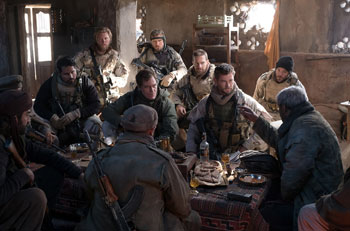 Recruiting The Cast
Recruiting The Cast
It's a helluva thing we do, isn't it? How do you
love your family and leave them to go to war?
Chris Hemsworth heads the cast as the leader of ODA-595, Captain Mitch Nelson. Mitch Nelson is not his commanding officer's first choice to lead his men into Afghanistan; in fact, just a week earlier, Nelson had transferred to a desk job that left his team without a Captain, effectively taking them off the line. Additionally, although he had been training with his men for two years, unlike them, he had never actually been in combat.
Chris Hemsworth expands, 'At the start of the film, Mitch Nelson has taken an administrative position that will keep him close to home and family. But when the 9/11 attacks happen, all of that changes. Like everyone else in uniform, he wants to be in the fight; he wants to be out there defending his country. But first he has to convince his superiors to give him back his team...and then to send them in."
'They don't think Nelson's unit should be the first one in because of his inexperience in war," Jerry Bruckheimer explains. 'But Nelson says that nobody has ever done anything like this, so that shouldn't put him at a disadvantage. His passion for the mission dispels their doubts." With five other Special Forces teams contending to be the first boots on the ground, Nelson alone demonstrates a realistic understanding of the unique challenges they will face. Despite the odds, he promises that he will accomplish in three months what they assumed would take six and guarantees he will bring everyone home...alive.
Nicolai Fuglsig notes, 'Captain Nelson approaches every situation head-on with a straightforward, no-nonsense attitude. He's a loving husband and father who deeply cares about protecting his family, and part of the way he can protect them is by being a great soldier. 'It's always a challenge to accurately portray a great leader like Captain Nelson," the director continues, 'but Chris Hemsworth has such quiet strength and confidence that his performance felt so natural. He was totally committed to the role and it was a privilege to direct him. It's always a pleasure to work with such a true professional."
The admiration is mutual. 'Nicolai Fuglsigi had so much excitement about what we were all part of," says Chris Hemsworth. 'His vision for the film and his attention to every little detail was wonderful. The way he sets the scene makes it feel as real as possible and puts you right in the center of the action. So it doesn't feel like heightened reality; it feels truthful and shocking and immediate."
By far the most seasoned member of ODA-595 is Chief Warrant Officer Hal Spencer, played by Michael Shannon. Unlike Nelson, Spencer has seen his fair share of action, but in their two years of training together, Nelson has earned his respect, and Spencer's expressed trust in the captain's abilities to lead them does hold some sway in the decision to reunite Nelson with his unit.
Nicolai Fuglsig attests, 'Spencer is highly respected by both his team and the senior officers, so his opinion carries a lot of weight. In this situation, Spencer believes in Nelson and follows his lead, but he still draws on his extensive experience to advise his younger captain. The way Michael Shannon was able to embody Spencer as this wise, battle-honed warrior was amazing. He is just an extraordinary actor."
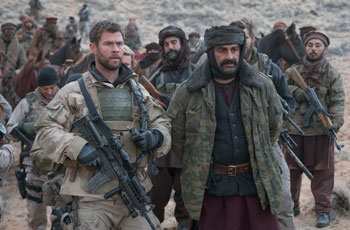 Describing his character, Shannon offers, 'Hal Spencer has been in the service for a long time and is starting to think that maybe it's a good time to retire and spend time with his wife and son. But when 9/11 happens, he cannot turn his back on that...he can't let that go unanswered. Even though he's past his prime, he still has something to offer. So one last mission, why not?"
Describing his character, Shannon offers, 'Hal Spencer has been in the service for a long time and is starting to think that maybe it's a good time to retire and spend time with his wife and son. But when 9/11 happens, he cannot turn his back on that...he can't let that go unanswered. Even though he's past his prime, he still has something to offer. So one last mission, why not?"
Jerry Bruckheimer, who had worked with Shannon on 'Pearl Harbor," says, 'Michael is one of our great American actors. Whatever part he takes on, he does an enormous amount of research for the character and always comes up with an interesting take."
Michael Peña plays Sam Diller, who brings a dry sense of humor to the team. 'We wanted somebody who could add a little bit of levity to the equation," Trent Luckinbill relates, 'and Michael Peña has a great sense of comedic timing with one-liners and a bit of sarcasm and certainly brought all of that. But he is also a very talented dramatic actor, so it was easy for us to decide he was the right choice for the role."
Michael Peña says he was immediately drawn to the project by the script. 'When I first read it, I thought how it built the tension was really. There are so many variables and infinite possibilities of where the danger might be coming from, so you really don't know what's going to happen and I think that makes for a good movie."
Trevante Rhodes joins the ensemble as Ben Milo, whom he describes as 'the demo man, the weapons guy with a heart of gold. He's big and burly, but underneath he has a tender spot, which we see in his relationship with an Afghan kid named Najeeb. At first, Ben has no idea why this kid is following him around everywhere, but there comes a point when he understands how important it is to him, and it just touches his heart."
Nicolai Fuglsig reveals, 'Milo's relationship with Najeeb is one of my favorite elements of the film because of how genuinely Trevante was able to capture how it develops. For me, it represents the heart and soul of the movie."
Geoff Stults, who plays Sean Coffers, calls his character 'the team complainer. He's good at his job, but he's a smartass, which is fun to play because you can get away with saying whatever the hell you want," he laughs. 'That's the nature of a group like this in the Special Forces"they love each other, they'd sacrifice for one another, they would die for one another, but at the same time they have no problem making fun of one another and messing with each other."
'That brotherhood is at the base of everything," Rhodes concurs. 'It's one of the reasons they continue to do this"yes, to serve their country, but also that brotherhood. There's nothing like that relationship."
Twelve-year Navy veteran Kenny Sheard, who also served in Afghanistan, appears as the team's senior medic, Bill Bennett. He adds, 'That bond is very important because anything anyone does in the military, they know it's a team effort. So it felt right to have that camaraderie be a major aspect of the story."
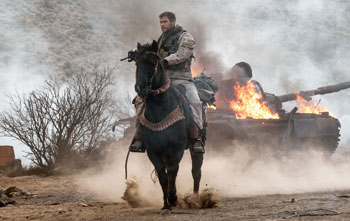 The ensemble also included another real-life military veteran: Jack Kesy, who plays Charles Jones, was with the United States Marines. He was actually just a few blocks from the World Trade Center when it fell, and served overseas in its aftermath.
The ensemble also included another real-life military veteran: Jack Kesy, who plays Charles Jones, was with the United States Marines. He was actually just a few blocks from the World Trade Center when it fell, and served overseas in its aftermath.
The other actors enlisted as ODA-595 are: Thad Luckinbill as Vern Michaels; Austin Hébert as Pat Essex; Austin Stowell as Fred Falls; Ben O'Toole as Scott Black; and Kenneth Miller as Kevin Jackson.
As the men prepare to leave on their mission, we meet the wives of Mitch Nelson, Hal Spencer and Sam Diller as they spend a few precious hours with their husbands before they go, steeling themselves for the anxious days and nights that they know lie ahead.
Molly Smith comments, 'We really wanted to show the conflicting emotions the wives may have. Some of them understandably do feel a bit angry or frustrated. They're sad, they're emotional...but they're also proud of what their husbands are doing. It's a very real and, I think, profound way to show a bit of what these families go through when they have to part, not knowing if it's the last time they'll ever see them."
Chris Hemsworth's real-life wife, Elsa Pataky, was cast as Nelson's supportive wife, Jean, marking the first time the two have acted together.
'We didn't need any prep time to form our chemistry," the actor admits with a smile. 'We've had seven years and three kids for that. But I am very proud of Elsa's work in the film." Elsa Pataky was not only pleased to work with her husband for the first time, but honored to play the wife of an American soldier. 'Jean knows she married a soldier and that these things are out of her control. It's painful to think about what might happen, but at the same time, Jean is so proud of Mitch and knows he's doing the right thing. It also creates a bond between the wives because they're going through the same thing. I really admire the strength of the families of every soldier who have been in those moments."
The crux of ODA-595's mission is gaining the trust of General Dostum, portrayed by Navid Negahban. The Iranian-born actor, who did an extensive amount of research on his character, relates, 'Dostum is an Uzbek leader in the Northern Alliance who has been at war since he was 16, fighting first against the Russians and now the Taliban, who murdered his family."
Nicolai Fuglsig adds, 'Dostum is such a strong, natural leader who commands respect wherever he goes, and I don't think I could have found a better actor to play him. I love how Navid delivers every line with such power and weight. He really brought Dostum's big personality to life."
The problem for Nelson and his men is that the trust of a lifelong warrior like Dostum is not easily won. 'There was huge mistrust," Negahban affirms, 'because Dostum was looking at them as a bunch of kids trying to tell him how to fight and save his country and the Americans were concerned that Dostum and his men might be setting them up. So it takes a while, but through the film you will see how they connect with each other, how they truly become blood brothers. For me, it is a very important story to tell. It's a different perspective"you see that the Afghans are fighting for exactly the same things that the Americans are fighting for. They just want to have their freedom, take care of their kids and be safe. That's it."
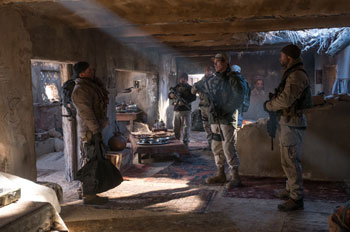 The actor continues, 'Nicolai Fuglsig's vision and how he wanted to honor these people was what got me to say yes. I wanted to be part of this film, but at the same time, I always want to do projects that mean something, and Nicolai Fuglsig gave me that. He became my safety net, the person I could lean on."
The actor continues, 'Nicolai Fuglsig's vision and how he wanted to honor these people was what got me to say yes. I wanted to be part of this film, but at the same time, I always want to do projects that mean something, and Nicolai Fuglsig gave me that. He became my safety net, the person I could lean on."
The senior officers who brief Nelson on the top secret mission are Colonel Mulholland, portrayed by William Fichtner, who has appeared in four Jerry Bruckheimer productions, including the war dramas 'Black Hawk Down" and 'Pearl Harbor," and Lieutenant Colonel Bowers, played by Rob Riggle.
Interestingly, Riggle, a Marine Corps veteran, has a singular connection to the true story of '12 Strong" and specifically to his role. He details, 'I had the pleasure of serving with the Third Battalion of the Special Forces group in November of 2001 in Mazar-i-Sharif. I was a young captain at Central Command at the time, and even though I'm a Marine, they sent me over to join up with these guys, and I ended up working under the command of Lt. Colonel Bowers. I wasn't a gunslinger like those guys, but it was a privilege to serve with them and help in whatever way I could with their mission. It's not very often you get to play your old boss on the big screen, and it was quite an honor. And I retired as a lieutenant colonel, so to play one on screen was also pretty cool."
Rounding out the main cast are Allison King as Marsha Spencer; Lauren Myers as Lisa Diller; young actor Arshia Mandavi as Najeeb; Laith Nakli as Commander Ahmed Lal and Fahim Fazli as Khaled, two members of Dostum's militia; and Numan Acar as Mullah Razzan, a brutal Taliban leader.
'Every member of the cast did such a fantastic job," Nicolai Fuglsig states. 'I can't believe how fortunate I was to work with these terrific actors."
Boot Camp
There's no playbook here.
We're gonna have to write it ourselves.
It is not unusual for actors playing members of the military to undertake some level of training in the interests of both authenticity and doing justice to those in uniform.
'Realism is extremely important, especially when you are endeavoring to tell a true story," Nicolai Fuglsig says. 'Our actors needed to experience firsthand some of what being part of a Special Forces team was really all about in order to accurately re-create the strategies employed by these types of soldiers in the field."
'Having the experts teach us about the Special Forces and this particular mission was invaluable," Chris Hemsworth adds. 'And learning together"doing the weapons training, the physical training and the movement drills"also helped cement us as a unit."
Austin Hébert says, 'In the few weeks we were together, we created a natural bond with one another. We learned that when you're out in the field, those are the only guys you have to count on for survival, and it gives you more confidence when you know your team is out there with you. So we had that going during boot camp, and it only grew throughout the film."
For both the actors and the filmmakers, the connection formed between the actors was as important to the veracity of their portrayals as the training. Jerry Bruckheimer emphasises, 'A vital part of the Special Forces is the camaraderie amongst the teams and how much they care about one another and depend on each other, and we wanted to instill that same feeling in our cast. When they did their military training, they built that same type of bond, which was wonderful to see and I think really comes through in the movie."
During pre-production, the actors came under the tutelage of veteran military advisor Harry Humphries and his team. A former Navy SEAL, Humphries has enjoyed a long association with Jerry Bruckheimer on a dozen films, including the acclaimed 'Black Hawk Down."
Thad Luckinbill offers, 'It was so important to have Harry and his group come in and teach us the ropes of how to handle weapons, how to properly communicate with one another, and how to move on a battlefield in different formations. We all learned a lot in a short amount of time, which was exciting."
Harry Humphries relates, 'We designed a specific training regimen for the guys, giving them the information and skills to help them believably play their characters. Weapons handling and safety was most important, but there was also tactical movement, patrolling and military vernacular.
'We typically started the day in classroom sessions where we gave them a sense of the language they would be using to communicate with one another," Harry Humphries continues. 'They got exposed to the structure of the Special Forces unit, and then we went into the basics of safe weapons handling, in this particular case the M4. They had to look comfortable handling a gun, and they needed to be safe doing it, so we drilled them repeatedly on magazine changes, weapons manipulation, clearing malfunctions... Then we got into movement. Every day, we replicated what we did the day before, and then expanded a little bit more each day. This film was blessed with a group of actors who sincerely respected the heroes they were playing. They wanted their characters to look correct, and worked hard to make that happen."
'Boot camp was amazing," adds Trevante Rhodes. 'Harry's team made sure we got everything down to a T. You have to focus on the logistics and the techniques so it becomes second nature"so when you're in the battle scenes, you don't have to think about it; it just happens."
According to Bob Pennington, their training paid off. 'One thing I liked about the film is that every one of those guys looked like a Special Forces Green Beret. I thought they represented us perfectly."
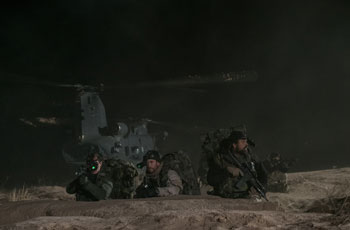 Saddle Up
Saddle Up
All right, who's ridden before?
Anyone?
The training of the '12 Strong" cast was twofold: in addition to being taught to act as elite Special Forces soldiers, they had to learn to ride horseback.
'I think all of us felt comfortable with our weapons and such on the ground," Chris Hemsworth says. 'Then we got on the horses and it sort of threw everything up in the air, but in a good way because these Special Forces guys were in that same situation. None of them knew what they were doing."
In the movie, Captain Nelson is the only experienced rider on the team, but nevertheless, it was important for the entire cast to be proficient enough to be safe on the horses, especially in the more rugged locations.
Animal wrangler Clay M. Lilley and his team were responsible for gathering and caring for the horses used in the production as well as teaching the actors to ride. 'The first thing we did was evaluate their riding skills," says Clay M. Lilley, 'and then we matched them to their horse. Several of the guys had never ridden at all, but they were all good to go by the time we got started filming."
Geoff Stults remarks, 'Everybody had to be brought up to speed to be able to ride and hit our mark. Part of it is feeling comfortable on the horse, because if you're nervous, the horse can tell, and that can be scary."
Getting comfortable on the horses was easier said than done when geared up for battle. Austin Stowell explains, 'I had ridden a little bit in the past, but nothing like what we needed to do for the film"holding your gun up and then having another 40 pounds on your back, trying to make it look real in the moment and, most importantly, not falling off. It was essential for us to train on the horses and work up to riding faster and turning tighter until it felt like second nature."
Thad Luckinbill grew up in Oklahoma, where he learned to ride, 'but, of course, it's been a while and I was a bit rusty," he admits. 'Clay and his guys assessed our abilities in the beginning, and I think they thought I was better than I was, so they gave me a really energetic horse. When we started shooting the first scene, he was just off to the races," he laughs. 'After that, we switched him for a calmer, more mature horse."
The Americans were not the only ones having to master the riding. It was perhaps even more vital for the actors playing their Afghan allies, who are all expert horsemen. Navid Negahban notes, 'I used to ride, but I hadn't been on a horse in more than 10 years. So it took a while, but I got more comfortable over time and it was good. The horse I rode is beautiful...strong and wild. He needs to be the first in the line; he doesn't like to follow other horses. He's actually exactly like Dostum's horse."
Michael Shannon says, 'I'm from Lexington, Kentucky, which is the horse capital of the world, but I never really rode much when I was a kid, and it's not something I get to do very often. But the horses were very sweet...and they've probably been in more movies than I have."
In fact, the equine actors employed in the film are all veterans of many previous productions, and their safety and well-being were paramount to the filmmakers. They were scrupulously cared for by Lilley and his team, under the constant supervision of a representative from the American Humane Association. Whenever a stunt or situation was deemed risky or inappropriate for live animals"including horse falls"sophisticated mechanical horses from the Oscar-winning artists at Creature Effects were utilized in their stead.
'Everything involving the horses was extremely regimented," Jerry Bruckheimer attests. 'We were fortunate to have a terrific team of knowledgeable professionals ensuring that they were never mistreated in any way. I'm very proud of what our people accomplished while keeping everyone"both humans and horses"safe."
On Location
You own the land, but we own the sky.
You want our bombs, talk to me.
'12 Strong" was shot entirely on location in New Mexico, which offered the filmmakers a blend of natural environments that closely resemble those of Afghanistan. The production would ultimately take the cast and crew to some of the most remote and arduous sites in the state, where they would all be tested by the vagaries of nature as well as the toughness of the terrain.
To capture the action, Fuglsig collaborated with cinematographer Rasmus Videbaek, whom he calls 'incredibly talented. One of the things Ras and I looked to convey is that when the team first gets off that Chinook helicopter, they feel like they're entering an entirely new world, so the photography of the landscapes became hugely important. We wanted to capture a desolate, barren, and bone-snapping cold visual palette."
'When Nicolai Fuglsig and I first started talking about the look of the film," Rasmus Videbaek says, 'he had a lot of references from photojournalism, as well as cinema. We decided to mix those two approaches"to be very real and intimate with the characters, but then, when they ride into battle, to go for more sweeping shots. So we used handheld cameras to give audiences the feeling of being right there with the guys, but utilized drones and aerial cameras and cranes to cover more epic sequences."
Nicolai Fuglsig was also intent on taking advantage of New Mexico's natural backdrops, instead of relying on soundstages or green screens. So it was incumbent upon his location scouts and design teams to find locations that worked, however remote they may have been. In some cases, the grip department built special rigs just to cable equipment up mountainsides and hillsides.
On the grounds of a shooting range north of Albuquerque, production designer Christopher Glass and his art department constructed a re-creation of Karshi-Khanabad, or 'K2," the military base situated in southern Uzbekistan near the Afghan border. The arrival point for ODA-595, the massive location set included 20 Quonset huts of varying sizes, along with guard towers, fencing and military vehicles. Adding to the realism, powerful Chinook and Black Hawk helicopters kicked up veritable tornados of dust and dirt, providing a dramatic effect for the cameras while invading every crevice of the equipment, not to mention the people.
The helicopters, pilots and crews were supplied by the Army's legendary 160th SOAR (Special Operations Aviation Regiment) Airborne 'Night Stalkers." Jerry Bruckheimer states, 'We were fortunate to work with the Night Stalkers on -Black Hawk Down.' They are the cream of the crop, the very best helicopter pilots in the service. They had just come back from deployment, so we were lucky the timing was right and we were able to get them."
For real-life Night Stalker Jeff Gladden, piloting the MH-47 Chinook for the filming of '12 Strong" was, he says, 'of the utmost importance. The flying scenes that we're doing here are exactly as they would have been done in Afghanistan. And these are the exact kind of aircraft that flew the men to their mission."
In order to replicate K2, Glass and his team had amassed an enormous amount of research. He details, 'In 2001, at the time of our story, K2 was very new, so we didn't want it to look as if it had been there for years. At the same time, those we spoke to who were there told us that the camp was very dour, very down and dirty, so we made sure the set reflected that." Rob Riggle confirms the authenticity of the film's K2, noting, 'I walked on the set and immediately felt like I was at the real K2. It felt as if I had stepped back in time."
Accuracy was equally important to costume designer Dan Lester, whose department engaged in extensive research on the uniforms worn by the Green Berets in 2001. He reveals that he also benefitted from the fact that 'one of my team is ex-Special Forces, so he had his own roots into getting information. Within a few weeks, we had a pretty good representation of what the basic uniforms looked like, but because they were Special Forces, we could tweak them a bit here and there to individualize their silhouettes."
As ODA-595's mission progressed, their costumes would naturally gather more and more dust and grime, so there were multiples of each uniform to go from beginning to end. 'We had an aging department, but in general," Dan Lester notes, 'you just never wash the clothes and they work so much better because they've actually lived in them. We also had the actors wear their uniforms through boot camp to get them used to the weight of them and get that natural wear."
After the scenes at K2, the company moved into sand dunes north of Albuquerque"at the end of the appropriately named Lost Horizon Drive"for the freezing cold and windy scenes of the Special Forces being delivered into the Afghanistan wilderness by the Chinook.
'Flying in the Chinook was unbelievable," Michael Peña says. 'The pilot hit his mark better than most people do with their feet. So we landed in the spot, the door opened up, and we were all running, and the amount of wind and sand blowing in our face...we were all tearing up. And it was tough because we did it, like, 30 times. There was a lot of adrenaline and everyone had puffy eyes."
It was also in these dunes that Nicolai Fuglsig directed scenes in the so-called 'Alamo," a dusty collection of atmospheric adobe buildings where the men of ODA-595 first meet General Dostum. The ramshackle structures were meticulously furnished by set decorator Wilhelm Pfau with authentic Afghan carpets, teapots, weaponry and ammunition, and even photos on the wall of martyred Northern Alliance leader Ahmad Shah Massoud.
One of the most remarkable shooting sites was the historic Iron Duke Mine, located more than 200 miles south of Albuquerque and at an elevation of 5800 feet above the desert floor. It served as the ideal stand-in for the Cobaki and Shulgareh cave command posts of General Dostum, with magnificent vistas from the steep cliffsides, of which Fuglsig and Videbaek took full advantage.
'The Cobaki Cave scenes were beautiful," recalls Chris Hemsworth. 'But it was freezing cold, and as visceral as it could be. If we had shot in a season other than winter, I don't think it would have been nearly as effective. Our performances were built around the environment."
Glass adds, 'When we first scouted the mine from a helicopter, we were blown away by the place. But logistically," he admits, 'it was one of the most difficult locations."
Both cast and crew traversed the winding, rocky heights on either tough little Gator fourwheel drive vehicles, or a five-ton military transport truck dubbed 'The Beast." Regardless, it was a bone-rattling ride, but worth every bump and jolt to give the film its scale and authenticity. Michael Shannon comments, 'The elevation was hard to deal with sometimes, and we would be out in the elements with the cold and wind and blowing sand. But we never lost sight of the fact that it was nothing compared to what the real guys actually went through."
'We were just actors playing our roles," adds Thad Luckinbill, 'but we had so much respect for what these Special Forces accomplished under much tougher conditions than anything we were facing. We each wanted to do our best to honor their story and get it right." The filmmakers also paid careful attention to representing the people and culture of Afghanistan. 'That's where Navid Negahban came to the rescue," asserts Fuglsig. 'He and some of the Afghan actors we cast went out of their way to reach out to an incredible community of Afghans across New Mexico and other regions. I was even lucky enough to find some wonderful actors among them."
In addition, Afghanistan native Mir Sharifi, who acted as an unofficial cultural advisor, assisted background casting director Sande Alessi with assembling Afghans living in the area to serve as extras. He and his family are important figures in the Afghan community of Albuquerque and New Mexico, and he had courageously worked with the U.S. Marine Corps as a cultural and language advisor for eight years. Sharifi also advised on the language and regional dialects, as well as consulting with Dan Lester's costume department.
The costume designer went to great lengths to obtain or design the proper dress for the Afghan characters and extras. 'I did a lot of research," says Dan Lester, 'and I also had people shopping in Afghanistan and they would send me pictures on my phone so I could choose what I wanted."
Dan Lester incorporated different color palettes to create a contrast between General Dostum's militia and their Taliban enemies. 'We stayed with warm earth tones for the Afghans, but used cooler tones, mostly grays and black, for the Taliban fighters."
Negahban also received a suitcase full of garments directly from Afghanistan, including a traditional chapan coat, exactly like the one worn by Dostum. The actor is also seen in a Russian jacket, which the general was wearing when capturing Mazar-i-Sharif.
The film's explosive climactic battle was staged amidst the looming cliffs of New Mexico's Thurgood Canyon, found some 50 miles beyond the gates of the massive White Sands Missile Range (WSMR). The location stood in for Afghanistan's Tiangi Gap, the dangerous chokepoint on the road to the strategically crucial city of Mazar-i-Sharif. There" vastly outnumbered, outgunned, and on horseback"the 12 Special Forces operatives of ODA- 595 and Dostrom's fighters would engage the Taliban and Al Qaeda forces, who were as intent on controlling Mazar-i-Sharif as the American and Afghan fighters were on driving them out. Fuglsig offers, 'The Tiangi Gap is a narrow passageway between the mountains and the only path that leads to Mazar-i-Sharif, which was being used as a Taliban stronghold. They had heavily fortified the entire length of the Tiangi Gap, making it extremely difficult for anyone to pass through." To capture the epic combat sequence, Fuglsig marshaled both the first and second units, the latter under the direction of Mic Rodgers, who also served as the film's supervising stunt coordinator.
With the invaluable cooperation of the military authorities at the WSMR, Glass and his department converted a large chunk of Thurgood Canyon, roughly the size of six football fields, into a battlefield. They then littered the area with the detritus of war, including 55 vehicles, mostly Russian-built, as that nation's spoils of war after leaving Afghanistan were then utilized by all sides of the conflict.
Eight Russian tanks figured into the fearsome array, along with artillery weapons, 'Technicals" (pickup trucks jerry-rigged with machine gun mounts), and a BM-21 'Grad" rocket launcher, which fires off a volley of 40 missiles and figures prominently in the battle.
Additionally, Glass details, 'We had about 13 surrogates, as they call them"fake tanks used as targets for bombing runs at WSMR." Conveniently for the production, many of the vehicles had already been half or completely destroyed, thanks to the fact that they had been used for demolition and bomb testing on the missile range.
Property master Curtis Akin and armorer Cory Wilde had the daunting task of obtaining or replicating the wide assortment of guns seen in the film. 'We did a comprehensive amount of research of what was being utilized by the Northern Alliance as well as the Taliban at that time," says Wilde. 'Their primary weapons were Russian made AK-47s, along with firearms from ageold conflicts in Afghanistan, including the bolt-action British Enfield. For the Special Forces, their weapon of choice was the M4 rifle. We also had RPGs (rocket propelled grenades), handguns, laser aiming devices, mortars, 50-caliber machine guns and more."
The most important 'vehicles" involved in the battle were the horses"both real ones and their realistic-looking mechanical stand-ins"provided by Creature Effects. For any shots in which the horses might be imperiled in any way, the production either called upon the mechanical horses or the visual effects team, supervised by Roger Nall.
The protection of the equine actors even extended to the preparation of the filming sites. Glass explains, 'We had to make horse paths that were safe. In the canyon that became the Tiangi Gap, we had to alter some of the landscape in consideration of the horses because they can't just run across fields of rocks. We also had fake debris that looks like metal, but it's actually roofing tar paper and rubber. We cut them up into pieces and threw them around so the horses could run across them without getting hurt. And we also had to think about the riders; if they were to fall off, we couldn't have them getting hurt by something hard or sharp. And, of course, everything was cleaned up when the location wrapped."
As the horses galloped through the canyon in what Mic Rodgers calls 'a classic cavalry charge," Rasmus Videbaek incorporated a variety of camera techniques to keep up with them. 'We had pursuit cars that could drive super-fast through the terrain with crane arms on top that could keep the image stabilized. We also had drones flying overhead and to the side. The great thing about horses is they are such cinematic animals; they look so great on film," says the cinematographer.
Special effects supervisor Mike Meinardus managed to coordinate the enormous number of physical effects throughout the film"including bullet hits, explosions and bomb blasts"with safety always foremost in mind. For Fuglsig, the realism was irreplaceable. 'I've always been a big fan of in-camera effects," he affirms. 'It was interesting to try and immerse our actors in situations that felt as real as possible. Everyone's performance became much more intense and we all felt as if we were living and breathing these moments of war."
Over the course of production, filming took place at a number of additional locations. A recreation area in the Albuquerque suburb of Los Lunas became the backdrop for scenes filmed on its 6,000-foot hillsides depicting battles in and around the Afghan village of Bescham. The heart of the historic Laguna Pueblo was converted by Glass's department into the Afghan village of Dehi, and was also seen as a road leading to the all-important city of Mazar-i-Sharif.
The Rio Grande stood in for Kentucky's Cumberland River, where we see members of ODA-595 up to their chests in the cold water for a training exercise that is suddenly interrupted by the events of 9/11. A former community college building was turned into the Special Forces headquarters at Fort Campbell, including offices and a mess hall, where the stunned military personnel gather to watch television reports of the horrific attacks.
A residential neighborhood in Albuquerque provided the family homes of Mitch Nelson, Hal Spencer and Sam Diller, where we see them preparing to say goodbye to their wives who, as longtime Army spouses, know the drill all too well and bravely accept the inevitable.
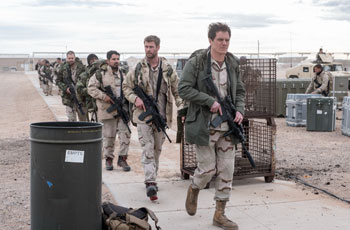 On The Home Front
On The Home Front
I don't care how long you're gone...
as long as you come back.
Following the wrap of principal photography, Fuglsig began the process of cutting the film with editor Lisa Lassek. He also collaborated with composer Lorne Balfe, who wrote the score for '12 Strong."
Lorne Balfe notes, 'When creating the score with Nicolai Fuglsig, we agreed that the music should not be overwhelmingly orchestral. The emotion was in the story and in the performances, and we wanted to be respectful of that, so we went for a hybrid soundtrack, mainly using a smaller ensemble."
Lorne Balfe's resulting score accompanies the courageous, emotional, perilous and ultimately triumphant journey of the Green Berets from the home front to the battlefront. Chris Hemsworth reflects, 'I hope the film gives audiences some insight into not only what this team did in those uncertain days after 9/11, but also what all Special Forces teams do every day without fanfare. I want people to come away with more of an understanding of the brave men and women who risk their lives to protect ours."
'There's actually a statue at Ground Zero honoring the accomplishments of these men," Jerry Bruckheimer notes. 'But what we learned is that, even though the statue is there, most people still had no idea what it was for or even that this ever happened. I always like to tell stories about real people who did extraordinary things, and what these -12 Strong' achieved and the commitment that they and their families have for protecting our freedom should never be forgotten."
Nicolai Fuglsig concludes, 'I hope audiences are inspired by the story of these 12 brave American soldiers. They traveled halfway around the world to join forces with people from a completely different cultural background in order to fight a common enemy we still don't fully understand. They had no idea what they would encounter, yet they still volunteered to leave their families and fight for the safety of their country. That is what truly makes these men heroes and why I believe their story deserves to be told."
12 Strong
Release Date: March, 2018
MORE
- Mission: Impossible Fallout
- Glenn Close The Wife
- Allison Chhorn Stanley's Mouth Interview
- Benicio Del Toro Sicario: Day of the Soldado
- Dame Judi Dench Tea With The Dames
- Sandra Bullock Ocean's 8
- Chris Pratt Jurassic World: Fallen Kingdom
- Claudia Sangiorgi Dalimore and Michelle Grace...
- Rachel McAdams Disobedience Interview
- Sebastián Lelio and Alessandro Nivola...
- Perri Cummings Trench Interview



